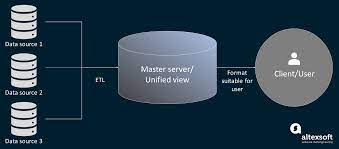Data integration is the process of combining data from multiple sources, formats, or systems into a unified and coherent view. It involves transforming, harmonizing, and consolidating data to provide a consistent and accurate representation of information for analysis, reporting, and decision-making purposes. Here are some key concepts related to data integration:
- Data Sources:
Data integration starts with identifying and connecting to various data sources that contain the relevant information. Data sources can include databases, flat files, web services, cloud-based applications, spreadsheets, and more. Each source may have its own data formats, structures, and access mechanisms. - Data Transformation:
Data transformation involves converting and mapping data from the source format to the target format. It includes tasks such as data cleansing, data validation, data enrichment, data aggregation, and data normalization. Transformation rules are applied to ensure consistency, conformity, and quality of the integrated data. - Data Mapping:
Data mapping refers to the process of defining the relationships between data elements in different data sources. It involves identifying corresponding fields, attributes, or columns in the source and target systems. Data mapping ensures that data is correctly transformed and aligned during the integration process. - Data Consolidation:
Data consolidation involves combining data from multiple sources into a single, unified view. It eliminates duplication and redundancy by merging similar data elements. Data consolidation helps to create a comprehensive and holistic representation of the data, enabling effective analysis and reporting. - Data Synchronization:
Data synchronization ensures that data across different systems or databases remains consistent and up-to-date. It involves capturing changes made to the source data and applying them to the target systems in near-real time or scheduled intervals. Synchronization ensures that all integrated data remains accurate and consistent. - Data Quality:
Data quality is critical in data integration. It refers to the accuracy, completeness, consistency, and reliability of the integrated data. Data quality processes, such as data profiling, data cleansing, and data validation, are applied to identify and correct errors or inconsistencies in the integrated data. - ETL (Extract, Transform, Load):
ETL is a common approach used in data integration. It involves extracting data from source systems, transforming it to meet the target system’s requirements, and loading it into the target system. ETL processes typically include data extraction, data transformation, and data loading phases. - Data Governance:
Data governance is the framework and processes for managing and ensuring the quality, availability, integrity, and security of data assets. It includes defining data standards, establishing data policies, implementing data controls, and monitoring data compliance. Data governance ensures that data integration is carried out in a controlled and governed manner. - Real-time Integration:
Real-time data integration enables the immediate or near-immediate availability of data for integration purposes. It involves capturing and processing data in real-time, allowing organizations to make timely decisions based on the most up-to-date information. Real-time integration is often used in scenarios where data freshness and responsiveness are crucial.
Data integration plays a vital role in organizations’ ability to have a unified view of their data and leverage it for business insights and decision-making. By understanding these data integration concepts, organizations can design and implement effective data integration solutions to unlock the full value of their data assets.
SHARE
